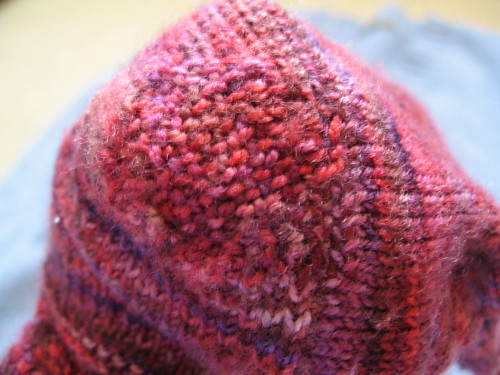Darn It! Part III
even if just darning holes in my socks.
Fortunately, all my socks are currently mended,
and I'm able to concentrate on fiction.
-Dean Koontz
I know, I know, while the flitgirl is channeling the Amish, Rachel is dreaming of petticoats, and Amanda is trying to teach her husband the finer points of Laura Ingalls Wilder's biography, the rest of you are scratching your heads thinking - Sheesh! Is she really going to talk about darning again? Originally, this was going to be a two-part series, but there were two compelling reasons to extend our fun. (Yes, I said, fun.)
First, questions:
Inquiring minds want to know if there is "Rogaine for socks." A pinch of prevention is worth a pound of cure. I knew Elizabeth was a smart woman.
Before we talk about preventing holes and thinning, we must all look deep into our souls and face The Cold Hard Truth: 100% wool socks wear out faster than wool-nylon blends. I know, I know. I could hardly bear it when I first realized. I buy Fair Trade coffee; I have a National Parks Pass; I handwash my socks. Clearly I want what is best for the world. But I have a lot of experience at this. My Regia socks that I've been wearing weekly for five years look brand new. My Koigu socks that I've been wearing less-than-weekly for three years, well, see the photo below. I've made 95 pairs of socks, people. Take my word for it.
The Step-by-Step Plan for Preventive Sock Knitting
- If you never want to get holes in handknit socks, don't knit socks.
- If you want to knit socks and reduce holes, buy sock yarn with 10-25% nylon (polyamid) content.
- If you insist upon 100% wool socks (and don't we all?):
- You could practice watchful waiting and perform duplicate stitch reinforcing at the first sign of thinning stitches.
- You could reinforce the heavy wear parts of the sock during/after knitting:
- by using reinforcing thread such as Wooly Nylon (sold at sewing stores) or leftover from other socks (it comes with Blauband and JaWoll sock brands); I've also heard of people using sewing thread, although I've never tried it
- by using the same yarn and weaving it through the purl bumps on the wrong side of the heavy wear spots
- Since we're speaking of reinforcing thread: People recommend using it while you knit the heels and toes. Well, I wear out all my socks at the ball of the foot and under the heel. Not so helpful for me.
- An alternative to reinforcing thread: You know our friend heel stitch? (sl 1, k1, purl back; Eye of Partridge would also work just fine) I've done that along the entire sole of the foot to reinforce it. Works great, although you may need to make the foot a little longer, since this shortens it. It's also a bit bulky. I recommend it for hiking socks.
- For all socks, gauge is crucial. More stitches per inch equals more yarn per inch. Automatic reinforcement if you go down a needle size.
- For all socks, knitting a correctly sized sock is critical. Too small, your toes will poke holes in them. Too big, they will move around in your shoes and create friction. Which is bad, because friction makes holes. Experiment. Find a great heel, a great toe, a perfect length, the perfect number of stitches on your favorite needles. This will help keep your socks in good shape.
Second, check out the darning on the Koigu sock:
 Big hole. Small yarn. But for my only pair of Koigu socks, totally worth it. This is a work of darning art.
Big hole. Small yarn. But for my only pair of Koigu socks, totally worth it. This is a work of darning art.



































22 Comments:
LOL! I knew you would know what to use for reinforcing - guess I need to make another trip to the yarn/fabric store (grin) now that I know what to buy.
Thanks - I'm loving this info! Since I have only eight pair, so far, they're pretty quick in the rotation, so wear is a problem!
Great job with the Koigu socks!!! You're inspiring.
95 pairs of socks!!!!!
W
Technique question: Rather than weaving a patch over a large area, would it be possible to knit the patch? You'd do a provisional cast on, knit to the appropriate size (or a little more), remove the provisional cast on, and then graft (via kitchener stitch) the beginning and end of the swatch/patch to the loose loops at either end of the hole. Or is that just too much effort, when weaving will do just as well?
p.s. It was great meeting you in Grafton!
Oh, that's actually a very lovely darn! I have to do the same thing to a pair of beloved Koigu socks. I plucked at a pill on the heel and discovered too late that it was a structural pill...
Hey, I was just thinking about darning eggs. I have some massage tools that are pretty much exactly the same shape and size. They could do double duty. Just a suggestion for anyone out there with a ridiculously large collection of massage therapy items (as well as hand-knit socks!)
Why on earth should I take sock advice from anyone who has knit fewer than 100 pairs of socks?
Just kidding. And this is a great post because prevention is definitely more my style than repair (I have a feeling that when push comes to shove, I may subscribe more to the Yarn Harlot's method of darning than yours). But this post gives me hope that I can at least delay my over-the-trash-can darning.
I'm going to wear my current handknit socks a few times and see what parts of them seem to wear out the quickest and then incorporate one or more of your techniques to strengthen those areas on future socks.
Darn, darn, darn. Great post. I missed the proverbial quote yesterday, love it!
95 pairs of socks? Gauge? Should fit? Live and learn.
That is a great darning job! I dread the day I have to darn, but now I know everything, right?
What a lovely darning job! And I don't blame you for going to the effort, because that's a beautiful sock. :)
You can get Koigu on Nantucket, which is not exactly the most accessible location in New England.
This is a great, timely series! I have one pair with a hole which has been in limbo waiting for me to decide whether to fix it or not, and a second pair that are "balding" at the heels. I'm off to find darning yarn.
Thanks for all the great tips! Now that I have entered the world of sock knitting, I need all the advice and tips I can get about keeping the socks happy and healthy.
Great tutorial! Seriously!
I'm still new enough to sock knitting that I haven't yet developed a need for this skill, but I can definitely see the merit!
what a wonderful series! thing is, i've avoided the whole darning thing altogether. i don't wear my socks. i know shocking. i just knit them and then store them in a drawer and look at them lovingly. maybe one day when i've knit more than 6 pairs i'll wear them.
Love the Koigu socks, of course, they are totally worth it!
I love your blog and wish I were still at Brown to be part of team College Hill!;)
Good darn tips, but I think I'll still follow the Harlot's method. =)
Excellent set of instructions. Thank you!
Thanks for the darning know-how. I was trying to pretend it would never be an issue, but at least now I know the darning part isn't so bad! Thanks for taking the time to write it all out for us :-)
Your tutorial will go in my knitting tips file. Rena Crockett's little booklet, Flawless Knit Repair, is another good resource. One thing I was sure to keep as a remembrance of my mom was a lovely worn wooden darning egg which was probably her mother's. Remember I Love Lucy and the darning egg she sewed into Ricky's sock? Maybe not- you are too young!
Excellent tips. Bookmarked for the inevitable "later".
Post a Comment
<< Home